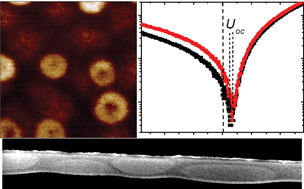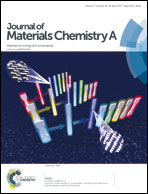Morphology and local electrical properties of PTB7:PC71BM blends†
Abstract
The power conversion efficiency of single layer organic solar cells can approach 10% with blends such as the polymer PTB7 and the fullerene derivative PC71BM. Here the detailed structure of PTB7:PC71BM blends deposited with and without addition of diiodooctane is studied by transmission electron microscopy and scanning probe microscopy. The details of bulk structure, such as the thickness of the layer covering fullerene domains and the grain structure of the film are examined. We find that fullerene-rich domains can be near the surface of the film or buried deeper, near the substrate. The local electrical properties of these blends are studied by conductive atomic force microscopy for different configurations of electrodes. Different power conversion efficiencies of blends with and without diiodooctane are explained in terms of local photoconductive properties.


 Please wait while we load your content...
Please wait while we load your content...